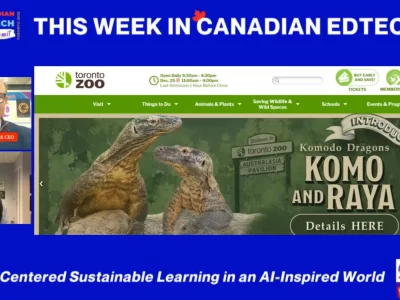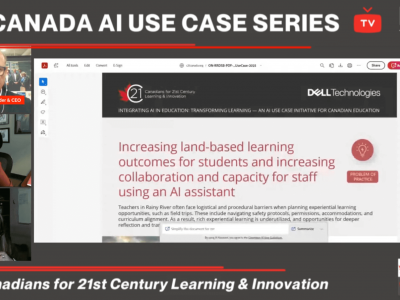In the book, Intentional Interruption, the authors note that new learning only happens when there’s cognitive discomfort. And cognitive discomfort occurs when we are faced with one or more ideas that challenge a belief that we readily accept as true, or at least, we hold as a cornerstone of our current professional practice. If we move from year to year without challenging our beliefs and making an effort to change our practice, then we will never face cognitive discomfort. That’s the easy road. We can continue down the path to professional oblivion making only slightly measurable changes in our teaching, and presumably, in students’ learning. How then do we even broach the idea of becoming innovative if we do not first embrace the need to engage in cognitive discomfort, or dissonance? There are, of course, no simple steps to becoming innovative, regardless of what you’ve read or what you’ve heard. If innovation were that easy, especially in teaching and learning, then it would be a common occurrence. Well, that’s simply not happening in today’s schools on a regular basis. Innovation is in many educational contexts a ‘buzz word.’ It’s been heard, but not seen. It’s an elusive idea that seems to escape even the most seasoned educator.
Let me bring five (5) ideas to encourage you to challenge your current method of teaching, even if you’re an experienced practitioner! These ideas are not the end of this discussion on innovation. They are merely the beginning of a lengthy discourse on the need for today’s teacher to embrace the awkwardness of changing practice because learning is not merely a knowledge level event. It’s an uncomfortable journey into a challenging world that requires one to examine those practices that are accepted as tried and true when perhaps they’ve become static and disengaging. You have the summer to develop a plan. Take small steps, but take them.
Embrace Discourse with Like-minded Practitioners
No one experiences cognitive discomfort in a vacuum. You must be ready to jump into professional relationships with like-minded individuals who yearn for excellence. And these people must be people you trust, are willing to share their strengths and weaknesses and who have the humility to avoid the ‘rock star’ mentality that exists in many professional learning contexts. In my own personal experience, I’ve known too few contexts where my colleagues were ready to challenge their professional practice and embrace more innovative ways to teach. And to be honest, I’ve had to face my own assumptions about my teaching practices and theories of learning that required ‘tweaking’ and critical examination. It’s humbling to have a colleague point out a ‘blind spot’ that needs attention, and critical reexamination. Can I accept the need to change my practice? Will I embrace humility and jump headlong into the throes of another’s thoughts and critiques of my teaching practice. To be frank, all teachers need this kind of discourse. Though it’s far from easy, and the learning is often brutally humiliating, in the end, our students get more effective teaching and a teacher who has been reawakened to what students experience from day to day.
Create Spaces that Encourage Innovation for both Staff and Students
We continue to talk about The Third Teacher. I think that more and more teachers are beginning to realize that our spaces play a significant role in creating conducive learning environments. At MindShare Learning we have supported the idea that schools should be embracing Learning Commons with Makerspaces. This means that a school should be reexamining their current spaces where research and collaboration occur – maybe libraries or learning commons – and redesign part of these spaces for creative hands-on learning. I don’t have space here to write about the synergies that are created in these kinds of contexts but know that at the very least you should re-think the traditional model of libraries and embrace a space that is 21st Century rich, inviting and dynamic. Students want to transfer their learning from the ideas to the practical; they want to examine today’s problems with today’s tools, and they want to help transform the society they live in because they’re becoming ever more aware that the stewardship of this world should not be left in the hands of adults.
We know that rich, inviting spaces help to propel innovation forward. They’re not the only catalyst, but they are a significant one. Walking into a space full of light, with areas developed for various modes of learning, stimulates thinking and creativity. What can you do to transform your space to become a hub of innovation for all stakeholders in your school?
Take a Risk and Jump Into Something New
Steve Jobs believed that different experiences outside of your norm helped to stimulate innovation. I couldn’t agree more. All of us are prone to adopt the same old, same old. It’s part of the way we create safe places for ourselves. We dislike the discomfort of facing challenges that may disrupt our practice and create that cognitive dissonance that actually creates new learning. So what does a risk look like? For each teacher, this risk will be different. For one teacher I knew taking a risk meant abandoning a traditional style of teaching mathematics. There was less of the textbook work and more of the open-ended and rich math tasks that broadened mathematical thinking and lead to deeper and transferred learning. This was not an easy path for this educator. She did, however, remain resilient and now enjoys a math class that is more engaging for both the students and herself. The sojourn was worth the time, effort and the sacrifice.
I think that teachers know where they can take a risk. We are aware of our comfort zones, what hasn’t been changed, and what needs to be critically reexamined. The issue is not where we might take the risk, but rather whether we have the impetus to do so. And this may mean that we’ll have to ask ourselves the meta-question of thinking about why we avoid taking risks when invariably we know that risk is a word that describes an event that may or may not have a positive outcome. But with each risk and failure comes deeper experiences of what will and won’t work. There’s always a win-win in risk taking in an educational context. If we fail to take risks, we’ll fail to push innovation forward.
Ask Your Students
I love the idea of embracing students’ opinions about what needs to change in school to meet their learning needs. Several years ago I tasked several classes of junior students to re-design our library space. What did we need to change in that area so that it became more dynamic, student-centered and collaborative? The results were amazing. In fact, the students opened up my eyes to new possibilities. Why? I believe they were unencumbered by a standard view of how this learning space was supposed to be designed. There were no barriers for them because they weren’t concerned by points of view that saw the space like a library. They wanted to create a student-friendly learning context that every student would enjoy. And they were not afraid to take risks!
So, ask your students. Ask your students, how you might redesign your classroom or school or learning commons, to meet their needs. And then get them involved in helping you make this innovation happen. I think you’ll be surprised by the outcome. You’ll also gain a critical group that will keep you honest in the outworking of your project or idea. That same group of students who proposed bold new designs of our learning commons continued to ask me when the change was going to happen and which particular ideas were going to be implemented. They’ll keep you on task, and they’ll actively support your desire to become more innovative.
Reflect, Re-work, and Remember
The process of becoming an innovative practitioner always involves reflection, re-working, and remembering. You will need to reflect often on your journey because innovation needs a critical eye and a critical mindset. I would suggest that you re-design an approach or take an entirely new approach in your teaching practice, you will have to keep a blog, or a ‘living document’ so that you can change direction or strategy as necessary. And the process of reflecting provides you with ‘aha’ moments that you might not have seen if you didn’t collect them in a blog, or journal. There is something to writing our thoughts down, whether we do it digitally, or in an analog way. And writing causes our brain to reconsider, and to reflect. We begin to ‘connect the dots’ and see bigger pictures and more important ideas.
Probably the best time to reflect, re-work and remember is now. At this point in the year, you’re probably full of memories of what worked, and what didn’t work in your classroom. You probably attempted ‘new’ things and made some mistakes from those inaugural ideas. Write them down! Reflect on them now and re-think how you might better approach those ideas next year. And take a critical approach where you think outside the box about those failures. With all of these thoughts coming to your mind now, it makes lots of sense to draw a draft plan for the next year. Work with a colleague and develop the plan collaboratively, with the full knowledge that your ideas may be challenged and you might experience cognitive discomfort.
Moving forward to become an innovative practitioner is no easy task. It involves hard work, a lot of reflection and a clarion call to shave away the rough edges of your teaching practice and to shine the bright light of critical examination on each aspect of your teaching practice so that you can become a master teacher. Too few master teachers exist. The reason is simple. No one wants to sacrifice comfort for a laborious re-working of teaching practices in a collaborative environment. Indeed, innovative practitioners avail themselves to those colleagues who can challenge their current assumptions and philosophies about teaching and learning. They put themselves ‘out there’ to be refined, and honed into the teacher that our students deserve. Do you care to be innovative? Be aware of the process. It is not for the feeble-hearted!








